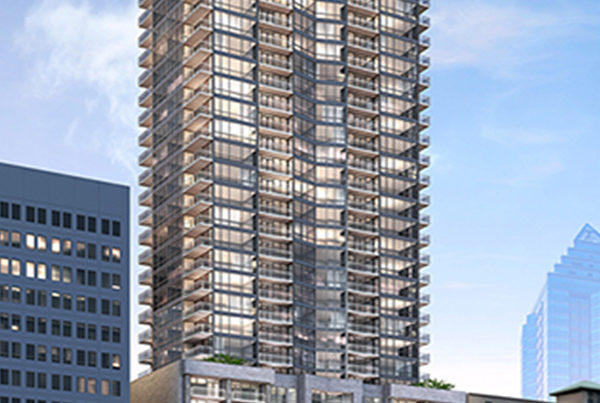For architects, engineers and installers, high-rise buildings present new challenges. The density of buildings, the scarcity of land and a competitive spirit among developers push modern buildings higher. These buildings push the limits of all the systems involved in creating a healthy and social living environment for their inhabitants.
Innovations to meet the challenges of building higher
The sheer height of a building changes the physical forces applied to plumbing systems, meaning conventional designs are no longer up to the job. This relates to pressure piping in the water supply system, and more importantly to the drainage system. In a high-rise building, a well-designed drainage system should operate without the user being aware of its existence.
These requirements are essential to achieve a safe, usable and reliable drainage system:
- The system should remove all soil and waste as quickly as possible
- Long horizontal pipe runs must be self-cleansing
- There must be minimal loss of water trap seal to ensure there is a barrier for the ingress of sewer gases and pathogens, so they cannot enter the living environment
In addition, the system should ensure:
- Minimal noise from the system
- Minimal odour from the appliance side
- Ease of maintenance
Outdated codes
In the past, code regulations were primarily designed for low- and mid-rise buildings, to ensure that inhabitants were protected from any contact with contaminated faecal material and resulting health risks. As a result, in developed industrialised countries, the majority of low- and medium-rise installations meet these standards, and the health risks from drainage systems are very low.
A high-rise building, in contrast, has a very dense population, interconnected on a single drainage system at highly-elevated discharge rates. Can the solutions developed for low- to medium-rise buildings be trusted to function effectively and safely? These codes, which weren’t written for high-rise installations, may not perform adequately in terms of space consumption and design cost-effectiveness – both of which are increasingly relevant in high-rise buildings where sellable floor space pricing is at a premium.
New approach for high-rises
Scientific and engineering research has improved our understanding of system operation, and contributed to the development of new, cost-effective ways to achieve safe, reliable drainage systems with no increase in health risk in high-rise buildings. These solutions are the backbone of properly-functioning “invisible” systems, providing savings in costs, time and space, and taking into account the specifics of the high-rise building in terms of height, shape, usage, and factors like wind loads.
As developers continue to strive for new heights, connecting more people and units to a single system, some critical questions need to be addressed:
- Do the current drainage building codes and standards meet the requirements of taller buildings?
- What is the best way to deal with issues around longer downpipes & higher loading inducing more transient pressures and the risks of depleting traps?
- High-rises and complex designs multiply the installation challenges. How feasible is it to design and build open & connected buildings?
- What is the best way to deal with wind shear at the top of the building influencing the pipe pressures?
- Today, no harmonised performance test protocols for high-rise drainage solutions exist. How can builders be sure that the required performance levels will be achieved?
Solutions
Aliaxis can help you solve these challenges and more. We offer a broad portfolio of innovative solutions, fully backed by expertise, knowledge and support, gained over more than five decades of experience. We can help you with:
Download our relevant Technical Papers
Aliaxis has a track record of introducing new, non-conventional concepts better suited to meet the specific challenges of high-rise buildings. Our experience is reflected in the numerous technical papers dedicated to high-rise that our experts have authored, which you can access by registering to download our technical papers.
Latest news
 Innovating Vertical Living: Aliaxis at Katowice Global Office Park
Innovating Vertical Living: Aliaxis at Katowice Global Office Park
 System XFR® Chosen for New Vancouver Hospital’s Piping Needsand System XFR®
System XFR® Chosen for New Vancouver Hospital’s Piping Needsand System XFR®
System XFR® Chosen for New Vancouver Hospital’s Piping Needsand System XFR®
 Ensuring quality and comfort at new Montreal condo thanks to AquaRise® and System XFR®
Ensuring quality and comfort at new Montreal condo thanks to AquaRise® and System XFR®
Ensuring quality and comfort at new Montreal condo thanks to AquaRise® and System XFR®
 Innovating Vertical Living: Aliaxis at Katowice Global Office Park
Innovating Vertical Living: Aliaxis at Katowice Global Office Park
Innovating Vertical Living: Aliaxis at Katowice Global Office Park
 System XFR® Chosen for New Vancouver Hospital’s Piping Needsand System XFR®
System XFR® Chosen for New Vancouver Hospital’s Piping Needsand System XFR®
